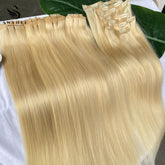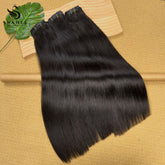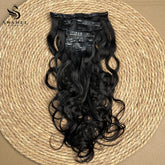How to Get Rid of Split Ends
Split ends. They creep up on you silently and then suddenly become all too noticeable. At first, they’re barely perceptible, just an occasional strand sticking out here or a frayed tip there. Nothing to worry about… a quick snip with the scissors or a dab of hair oil should fix it, right? However, before you know it, the consequences of skipping those regular salon visits catch up with you, and you’re left to deal with ragged ends, dryness, and a whole lot of frizz.
For some, split ends are a chronic problem, while others seem to effortlessly maintain long, strong, and healthy hair. Although genetics play a role in hair growth and its resistance to breakage, there are still plenty of steps you can take to reduce the risk of developing split ends. From what causes them to how to prevent them, we’ve got everything you need to know covered in the following sections.
What Are Split Ends?
Simply put, split ends occur when a single hair strand splits into two. If you’re someone who habitually and unconsciously tugs at those split ends, you’re probably all too familiar with this issue. But what exactly are split ends, and what happens if you leave them untreated?
From a scientific perspective, split ends are known as “trichoptilosis” — a name that sounds like some kind of disease — and they occur due to the splitting or fraying of the hair shaft. While split ends are most noticeable at the tips (since these areas have the oldest cells and are thus most prone to wear and tear), they can actually occur anywhere along the hair strand.
While it’s normal for hair to have a few split ends, an excessive amount is a red flag. They not only affect the appearance but also indicate that your hair is damaged, dry, and generally unhealthy. If you neglect proper care, the problem can quickly worsen, leading to severe breakage and making your hair brittle and prone to snapping. So, if you’ve never really checked your hair for split ends but notice that it seems to stop growing at a certain length, split ends might be the culprit.
What Causes Split Ends?
Poor Daily Hair Care Habits
Although genetics are a factor, there are many other elements that contribute to the appearance of split ends. The most common cause is poor daily habits, such as taking hot showers, brushing tangled hair, drying your hair by wrapping it in a towel, or sleeping with your hair tied up — all of which can lead to hair breakage and splitting. For most people, these care routines are so common that they unknowingly damage their hair.
Heat Styling
Frequent use of heat styling tools like hairdryers, straighteners, curling irons, and hot rollers can take a toll, as they strip the hair of its moisture, making it more brittle and prone to splitting.
Chemical Treatments
Chemical straightening, perming, as well as hair coloring or bleaching, all weaken the precious hair strands and increase the likelihood of split ends.
Using Inappropriate Hair Care Products
In addition, hair care products that contain a lot of drying agents and alcohol can further damage the hair, exacerbating dryness and breakage. Finally, if you’ve been patting yourself on the back for pulling out split ends or avoiding regular trims in an attempt to grow your hair longer, you’re actually doing more harm than good.
Climate and Weather
While most of the above factors are within your control, there are some lesser-known causes of split ends that are harder to spot and manage. Environmental factors like sun exposure or low air humidity can dry out your hair, making you more susceptible to split ends.
Poor Nutrition
Ever heard the saying “you are what you eat”? Well, it’s true! Nutritional deficiencies, vitamin shortages, and hormonal issues resulting from an unbalanced diet can all affect hair health.
How to Get Rid of Split Ends?
Trim the Ends
Unfortunately, once split ends appear, there’s no real way to eliminate them. The only solution for split ends is to trim them, which is why prevention is so crucial. Although it may sound counterintuitive, regular trims actually make your hair grow faster and healthier. Because if you don’t cut off the split ends, the hair will continue to break upwards along the shaft, resulting in even more frizz. You can try using smoothing hair products like hair oils, serums, gels, or pomades to moisturize your hair, reduce the visibility of split ends, hide sticking-out strands, and tame unruly frizz, but regular trimming is the fundamental solution to split ends.
Fake It
While prevention is the best approach, we know that achieving thick, healthy hair is a long process, especially if you’re prone to split ends and breakage or frequently color your hair and use heat styling tools. In the meantime, we’ve gathered some professional tips to help you temporarily improve the appearance of your hair until it recovers.
First, spray leave-in conditioner on your hair while it’s still damp. Then, apply hair oil or serum (natural formulas are best), focusing on the mid-lengths and ends to moisturize the hair and smooth the cuticles. Once your hair is completely dry, apply a small amount of product to the ends, which will make your hair look smoother and more polished. Finally, to deal with broken hair around the hairline or near the roots, use a toothbrush to apply a small amount of hair gel or smoothing pomade to tidy up any sticking-out strands.
Conceal with Wigs
Of course, if you want to take your hairstyle to the next level or make your hair look thicker, longer, and healthier, a set of Swanee wigs can make those split ends disappear. Even if your natural hair is relatively healthy but lacks the desired volume and length, wearing Swanee wigs can enhance your look.
Nourish Your Hair from the Inside Out
The top tip for achieving shiny, thick, and healthy long hair is to nourish your body through your diet. This means maintaining a balanced diet rich in fruits, vegetables, and healthy fats, and if you feel that you’re not getting enough nutrients from your diet alone, consider taking supplements.
Biotin and folic acid have been particularly proven to help improve hair health, increase length, and boost thickness. Biotin (found in walnuts, lentils, and brown rice) strengthens hair and nails by metabolizing fats, carbohydrates, and proteins, while folic acid (found in leafy greens and oranges) helps stimulate the production of red blood cells, fueling hair growth. Additionally, staying well-hydrated is crucial. Need more guidance? We have more information on a healthy hair care diet at [specific link].
Get Regular Trims
Make sure to get your hair trimmed regularly (every 6 to 8 weeks is ideal), which will nip the problem in the bud and prevent split ends from spreading upwards. It goes without saying that if you have the habit of tugging at split ends, stop immediately and then head to the salon for a trim.
Ultimately, the key is to keep your hair well-nourished and hydrated. While it’s impossible to completely avoid split ends, following the above advice and being more mindful when dealing with your hair will definitely reduce the risk of developing them.
Use the Right Products
Another way to prevent split ends is to reduce how often you wash your hair and use the right shampoos, conditioners, and styling products. For example, it’s best to avoid using overly harsh shampoos that are too abrasive and strip the hair of its natural oils.
Many traditional hair care products contain toxic chemicals, harsh drying agents, as well as ingredients like parabens and sulfates, which do more harm than good to your hair. Always check the ingredient list when shopping and choose natural hair care products whenever possible.
In addition, look out for products specifically designed for dry, damaged hair. Remember, while high-quality formulated products may cost more than traditional ones, it’s a proactive approach to hair care. Plus, it can save you from spending a fortune at the salon to repair damaged hair in the future.
Condition First
If your hair is particularly fragile, you can also try the “condition-wash-condition” method. Instead of starting with shampoo, apply conditioner to the mid-lengths and ends of your hair before washing. This helps strengthen and protect the hair, allowing it to retain moisture better. Finish off with another application of conditioner for extra shine and smoothness.
Avoid Hair Dyeing
While it’s best to keep your natural hair color, we know it’s not for everyone. So if you do color or bleach your hair, try to reduce the frequency or opt for more natural coloring techniques like balayage or highlights. These methods are easier to maintain and don’t require frequent touch-ups, saving you both money and your hair!
Use Heat Protectant Products
While it’s best to avoid using heat styling tools altogether, we know that’s not always possible. So always use heat protectant products before blow-drying, curling, or straightening your hair. While this won’t completely prevent heat damage, it will definitely help mitigate the harm caused by heat styling tools and reduce the likelihood of hair damage. Additionally, if you have the time, let your hair air dry before styling.
Turn Down the Heat
Avoid setting your heat styling tools to the highest temperature. It’s not only unnecessary but also extremely damaging to your hair. Similarly, when blow-drying your hair, use the medium heat setting instead of the high one.
Be Gentle with Your Hair
It’s also important to be as gentle as possible when handling your hair. For example, avoid brushing your hair right after a shower, as wet hair is more prone to breakage. Instead, use a wide-toothed comb in the shower to gently detangle your hair, starting from the ends and working your way up. Be gentle when drying your hair with a towel and avoid wringing it out. If possible, ditch the towel and use an old cotton T-shirt to dry your hair instead. Even something as simple as overwashing your hair can dry it out and make it brittle. Similarly, if you love wearing your hair in a ponytail, you might want to reconsider; elastic bands and hair ties can cause tangles, so it’s best to tie your hair loosely and choose hair rings or clips instead of traditional elastic bands.
Use a Silk Pillowcase
Other tips include sleeping with your hair loose and switching from a cotton pillowcase to a silk one; silk pillowcases are smoother and prevent your hair from tangling as you toss and turn, and they can also help prevent wrinkles.
So, whether you’ve been struggling with split ends for a long time or just notice them occasionally as a reminder that it’s time for a haircut, a combination of prevention and regular trims is the best solution. By maintaining a balanced diet, using the right products, reducing heat damage, avoiding chemical treatments, and being gentle when styling and handling your hair, you can significantly improve the health of your hair over time. Trust us, achieving thick, healthy long hair is easier than you might think.








